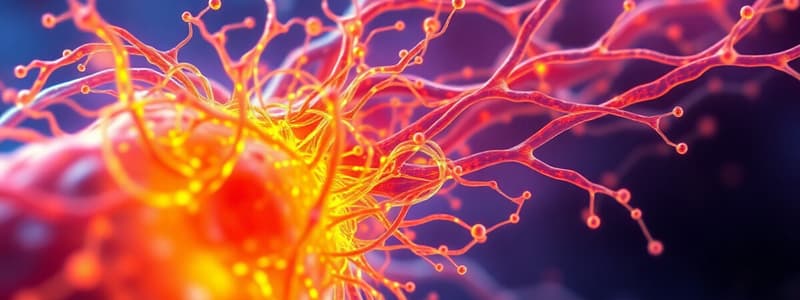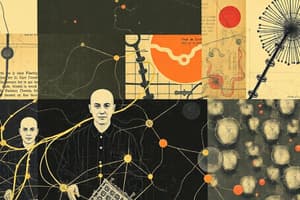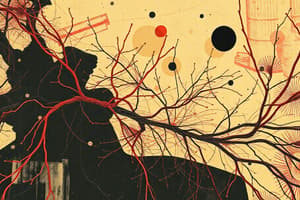Podcast
Questions and Answers
¿Qué describe el proceso de ‘intercambio rotatorio’ en los microfilamentos de actina?
¿Qué describe el proceso de ‘intercambio rotatorio’ en los microfilamentos de actina?
- El aumento continuo de la longitud del filamento de actina.
- La ruptura y reintegración de subunidades sin cambio neto en la longitud. (correct)
- La eliminación total de actina de la estructura celular.
- La transferencia de actina entre diferentes organelos celulares.
¿Cuál de las siguientes fases no forma parte del ensamblaje de un filamento de actina?
¿Cuál de las siguientes fases no forma parte del ensamblaje de un filamento de actina?
- Nucleación
- Elongación
- Steady-State
- Despolimerización (correct)
¿Cuál es la característica importante de los microfilamentos de actina en términos de estructura?
¿Cuál es la característica importante de los microfilamentos de actina en términos de estructura?
- Presentan polaridad. (correct)
- No presentan polaridad.
- Alteran su estructura según la concentración de actina.
- Son siempre irreversibles en su formación.
¿Qué importante proteína es necesaria para el correcto funcionamiento de los microfilamentos?
¿Qué importante proteína es necesaria para el correcto funcionamiento de los microfilamentos?
¿Qué se consume durante la formación de microfilamentos de actina?
¿Qué se consume durante la formación de microfilamentos de actina?
¿Dónde se encuentra la clorofila en los células mencionadas?
¿Dónde se encuentra la clorofila en los células mencionadas?
¿Cuál es la función principal del nucléolo en la célula?
¿Cuál es la función principal del nucléolo en la célula?
¿Qué pigmento se encuentra en los gránulos denominados cianosomas?
¿Qué pigmento se encuentra en los gránulos denominados cianosomas?
¿Qué efecto tiene un cambio en la osmolaridad del líquido extracelular (LEC) sobre las células?
¿Qué efecto tiene un cambio en la osmolaridad del líquido extracelular (LEC) sobre las células?
¿Qué estructura forma parte del sistema de membranas interno de la célula?
¿Qué estructura forma parte del sistema de membranas interno de la célula?
¿Cuál de los siguientes no es un componente del medio celular?
¿Cuál de los siguientes no es un componente del medio celular?
¿Cómo se desarrollan las algas mencionadas según el contenido?
¿Cómo se desarrollan las algas mencionadas según el contenido?
¿Qué función cumplen juntos la clorofila y la ficobilina?
¿Qué función cumplen juntos la clorofila y la ficobilina?
¿Qué proceso ocurre cuando el agua se mueve para igualar las concentraciones en el líquido extracelular e intracelular?
¿Qué proceso ocurre cuando el agua se mueve para igualar las concentraciones en el líquido extracelular e intracelular?
¿Cuál es la función principal del citoesqueleto en las células?
¿Cuál es la función principal del citoesqueleto en las células?
¿Qué se entiende como la 'envoltura adherens'?
¿Qué se entiende como la 'envoltura adherens'?
¿Cuál es el rol principal del agua en el medio celular?
¿Cuál es el rol principal del agua en el medio celular?
¿Qué representan los cianosomas en la célula?
¿Qué representan los cianosomas en la célula?
Durante la crenación, ¿qué ocurre con la célula?
Durante la crenación, ¿qué ocurre con la célula?
¿Qué tipo de filamentos NO forma parte del citoesqueleto?
¿Qué tipo de filamentos NO forma parte del citoesqueleto?
Los filamentos de actina son conocidos por su papel en:
Los filamentos de actina son conocidos por su papel en:
¿Qué tipo de sustancias están disueltas o suspendidas en el agua del medio celular?
¿Qué tipo de sustancias están disueltas o suspendidas en el agua del medio celular?
Los tres tipos de filamentos del citoesqueleto comparten:
Los tres tipos de filamentos del citoesqueleto comparten:
¿Qué se entiende por citólisis?
¿Qué se entiende por citólisis?
Los iones desempeñan un papel importante en el medio celular. ¿Cuál de los siguientes iones es esencial para funciones neurológicas?
Los iones desempeñan un papel importante en el medio celular. ¿Cuál de los siguientes iones es esencial para funciones neurológicas?
La capacidad de los filamentos del citoesqueleto para actuar de manera conjunta es crucial para:
La capacidad de los filamentos del citoesqueleto para actuar de manera conjunta es crucial para:
¿Qué función tienen los microtúbulos en el citoesqueleto?
¿Qué función tienen los microtúbulos en el citoesqueleto?
¿Cuál de las siguientes afirmaciones sobre los filamentos intermedios es CORRECTA?
¿Cuál de las siguientes afirmaciones sobre los filamentos intermedios es CORRECTA?
La capacidad de las células para reestructurar sus componentes internos se debe a:
La capacidad de las células para reestructurar sus componentes internos se debe a:
¿Qué característica es exclusiva de las células eucariotas?
¿Qué característica es exclusiva de las células eucariotas?
¿Cuál de las siguientes afirmaciones sobre las células procariotas es correcta?
¿Cuál de las siguientes afirmaciones sobre las células procariotas es correcta?
¿Cuál es la respiración predominante en las células eucariotas?
¿Cuál es la respiración predominante en las células eucariotas?
¿Qué función desempeñan las mitocondrias?
¿Qué función desempeñan las mitocondrias?
¿Cuál es una característica que no presentan las células procariotas?
¿Cuál es una característica que no presentan las células procariotas?
En términos de tamaño, ¿cómo se comparan las células eucariotas con las procariotas?
En términos de tamaño, ¿cómo se comparan las células eucariotas con las procariotas?
¿Qué tipo de división celular es común en las células procariotas?
¿Qué tipo de división celular es común en las células procariotas?
¿Cuál de las siguientes estructuras es típica de las células eucariotas?
¿Cuál de las siguientes estructuras es típica de las células eucariotas?
¿Cuál es la función principal de las proteínas motoras en el citoesqueleto?
¿Cuál es la función principal de las proteínas motoras en el citoesqueleto?
¿Cómo interactúan los filamentos del citoesqueleto con otros componentes celulares?
¿Cómo interactúan los filamentos del citoesqueleto con otros componentes celulares?
¿Qué característica del citoesqueleto le permite ser dinámico y remodelarse continuamente?
¿Qué característica del citoesqueleto le permite ser dinámico y remodelarse continuamente?
¿Qué permite al citoesqueleto definir la polaridad celular?
¿Qué permite al citoesqueleto definir la polaridad celular?
¿Cuál es un ejemplo de cómo los filamentos del citoesqueleto son regulados?
¿Cuál es un ejemplo de cómo los filamentos del citoesqueleto son regulados?
¿Qué significado tiene que el citoesqueleto sea capaz de formar protrusiones especializadas?
¿Qué significado tiene que el citoesqueleto sea capaz de formar protrusiones especializadas?
¿Cuánto tiempo lleva el citoesqueleto en ser reemplazado y remodelado?
¿Cuánto tiempo lleva el citoesqueleto en ser reemplazado y remodelado?
¿Cuál es la principal propiedad de los filamentos del citoesqueleto?
¿Cuál es la principal propiedad de los filamentos del citoesqueleto?
Flashcards
Cytosol
Cytosol
The intracellular fluid component of a cell
LEC
LEC
Extracellular fluid
Osmolarity Changes (LEC)
Osmolarity Changes (LEC)
A shift in solute concentration in the extracellular fluid
Osmosis
Osmosis
Signup and view all the flashcards
Crenation
Crenation
Signup and view all the flashcards
Equilibrium Dynamic
Equilibrium Dynamic
Signup and view all the flashcards
Cytolysis
Cytolysis
Signup and view all the flashcards
Intracellular Fluid
Intracellular Fluid
Signup and view all the flashcards
Cytoskeleton function
Cytoskeleton function
Signup and view all the flashcards
Cytoskeleton components
Cytoskeleton components
Signup and view all the flashcards
Actin filaments
Actin filaments
Signup and view all the flashcards
Microtubules
Microtubules
Signup and view all the flashcards
Intermediate filaments
Intermediate filaments
Signup and view all the flashcards
Cytoskeleton's role
Cytoskeleton's role
Signup and view all the flashcards
Cell adaptation
Cell adaptation
Signup and view all the flashcards
Mechanical properties
Mechanical properties
Signup and view all the flashcards
Cytoskeleton Filaments
Cytoskeleton Filaments
Signup and view all the flashcards
Accessory Proteins
Accessory Proteins
Signup and view all the flashcards
Motor Proteins
Motor Proteins
Signup and view all the flashcards
Dynamic Cytoskeleton
Dynamic Cytoskeleton
Signup and view all the flashcards
Cellular Polarity
Cellular Polarity
Signup and view all the flashcards
Cytoskeleton & Cell Movement
Cytoskeleton & Cell Movement
Signup and view all the flashcards
Filament types
Filament types
Signup and view all the flashcards
Cytoskeleton Stability
Cytoskeleton Stability
Signup and view all the flashcards
Prokaryotic Cell
Prokaryotic Cell
Signup and view all the flashcards
Eukaryotic Cell
Eukaryotic Cell
Signup and view all the flashcards
Cell Complexity
Cell Complexity
Signup and view all the flashcards
Cell Size Variation
Cell Size Variation
Signup and view all the flashcards
Cell Shape Diversity
Cell Shape Diversity
Signup and view all the flashcards
Cell Obtaining Energy
Cell Obtaining Energy
Signup and view all the flashcards
Responding to Stimuli
Responding to Stimuli
Signup and view all the flashcards
Cell Organization
Cell Organization
Signup and view all the flashcards
Actin Filament Treadmilling
Actin Filament Treadmilling
Signup and view all the flashcards
Microfilament Assembly
Microfilament Assembly
Signup and view all the flashcards
Polarity in Actin Filaments
Polarity in Actin Filaments
Signup and view all the flashcards
Actin Filament Nucleation
Actin Filament Nucleation
Signup and view all the flashcards
Steady-State in Actin Filament Assembly
Steady-State in Actin Filament Assembly
Signup and view all the flashcards
Chlorophyll location
Chlorophyll location
Signup and view all the flashcards
Ficobilins location
Ficobilins location
Signup and view all the flashcards
Cianosomas & laminillas function
Cianosomas & laminillas function
Signup and view all the flashcards
Cellular membrane system
Cellular membrane system
Signup and view all the flashcards
Nucleolus Function
Nucleolus Function
Signup and view all the flashcards
Pigments & extreme conditions
Pigments & extreme conditions
Signup and view all the flashcards
Cell Membranes & reactions
Cell Membranes & reactions
Signup and view all the flashcards
Photosynthesis in Algae
Photosynthesis in Algae
Signup and view all the flashcards
Study Notes
General Information
- Course: Biología Celular y Tisular
- Module: I
- Academic Year: 2024/2025
- Professor: Cristina Yunta Yanes
- Degree: Grado de Fisioterapia
Topic 1: Evolución y organización estructural de la célula
- Biología Celular y Tisular is the topic of the course.
- Key question in biology: What does it mean to be alive?
- What are the fundamental properties that characterize all living things and distinguish them from inanimate or non-living matter?
- These are the questions that cellular theory answers.
- Living things are capable of growing, reproducing, processing information, communicating, responding to stimuli, and carrying out a wide variety of chemical reactions.
- All living organisms are made up of cells.
- A cell is a fundamental unit for the organization and function of the body.
- Biology: The area of knowledge responsible for the study of living matter.
- Cellular studies can be descriptive—studying the structure of living things—or functional—studying the vital processes of organisms.
- Continuous cell proliferation and differentiation lead to the formation of different tissues in the body.
- A single initial cell (produced from fertilization) gives rise to hundreds of different cell types differing in content, shape, size, color, mobility, and surface composition.
- Cells must be organized into tissues, organs, and systems.
- Levels of organization:
- Chemical (atoms and molecules)
- Cellular
- Tissue
- Organ
- Organ system
- Organism
Topic 2: La célula
- Cells are alive and are able to die via apoptosis.
- Cells contain genetic material (subject to change) and the means to use it.
- Cells can evolve.
- Cells can replicate.
- Cells obtain energy through chemical reactions.
- Cells react to stimuli and exhibit self-regulation.
- Cells are complex and capable of organization.
- Cells → Tissues → Organs → Organ systems → Organism
- Cells are highly variable in size.
- Cells display diverse shapes.
- The main types of cells are determined by their specialization (epithelial, muscle, nerve, etc.).
Topic 2: La célula - Clasificación Celular
- Simpler cell classification: prokaryotic and eukaryotic.
- Key difference between prokaryotic and eukaryotic cells:
Feature Prokaryotic Eukaryotic Size 1-10 µm 10-100 µm Nucleus No Yes Nucleolus No Yes Ribosomes 70S (50S + 30S) 80S (60S + 40S) Endomembrane system No Yes Mitochondria No Yes Chloroplasts No Yes Respiration Anaerobic/Aerobic Aerobic Cell division Amitosis (binary fission) Mitosis/Meiosis Genetic material Proteins not histones Histones
Topic 2: La célula - Clasificación Celular (Animal vs. Vegetal)
- Animal cells lack chloroplasts, cell walls, and large vacuoles but have centrosomes.
- Plant cells have chloroplasts, cell walls, and large vacuoles but lack centrosomes.
Topic 3: El citoesqueleto
- The cytoskeleton is a dynamic and adaptable system of filaments that form a framework throughout the cell.
- It organizes internal structures, facilitates intracellular traffic, and allows cell division and movement.
- The cytoskeleton is made up of three different types of filaments: microfilaments, intermediate filaments, and microtubules.
- The properties (structure, composition, arrangement, and function) of each type of filament vary.
Topic 4: Sistema de endomembranas
- A complex of internal cellular membranes.
- Only present in eukaryotic cells.
- Divides the cell into different compartments that are structurally and functionally distinct.
- The basis of this membrane complex is the lipid bilayer, which is the same in all membrane components.
- The endomembrane systems are found throughout the cytoplasm, either individually in vesicles or grouped as organelles.
- Includes the rough endoplasmic reticulum (RER) , smooth endoplasmic reticulum (SER), Golgi apparatus, lysosomes, peroxisomes, and vesicles of various types.
Topic 5: La célula animal-membrana plasmática y matriz extracelular
- A cell is surrounded by the plasma membrane, which delineates it from the extracellular environment.
- Its fundamental components are lipids (phospholipids, cholesterol, glycolipids), proteins (integral and peripheral), and carbohydrates (glycoproteins, glycolipids).
- The plasma membrane is held together through hydrophobic interactions and van der Waals forces between the fatty acid tails.
- This structural organization is critical for the membrane's stability and dynamic properties.
- The membrane-bound compartments of the eukaryotic cell are separated by different forms of lipid and protein assemblies.
Topic 6: La matriz extracelular
- The extracellular matrix provides the cellular environment.
- It is largely made up of proteins, carbohydrates, and various other molecules.
- The components of the extracellular matrix are continuously synthesized and degraded.
- The structure and composition of the extracellular matrix vary according to the tissue type.
- Key structural elements are proteoglycans (proteins with GAGs attached) and fibrous elements including collagens, elastic fibers, and reticular fibers.
- This matrix plays a crucial role in cell organization, tissue structure, cell behavior, and physiological function.
Topic 7: Uniones intercelulares
- Specific proteins mediate cell adhesion and communication.
- These include:
- Tight junctions
- Adherens junctions
- Desmosomes
- Gap junctions
- These specialized structures allow cells to form tissues and coordinate their actions.
Studying That Suits You
Use AI to generate personalized quizzes and flashcards to suit your learning preferences.




